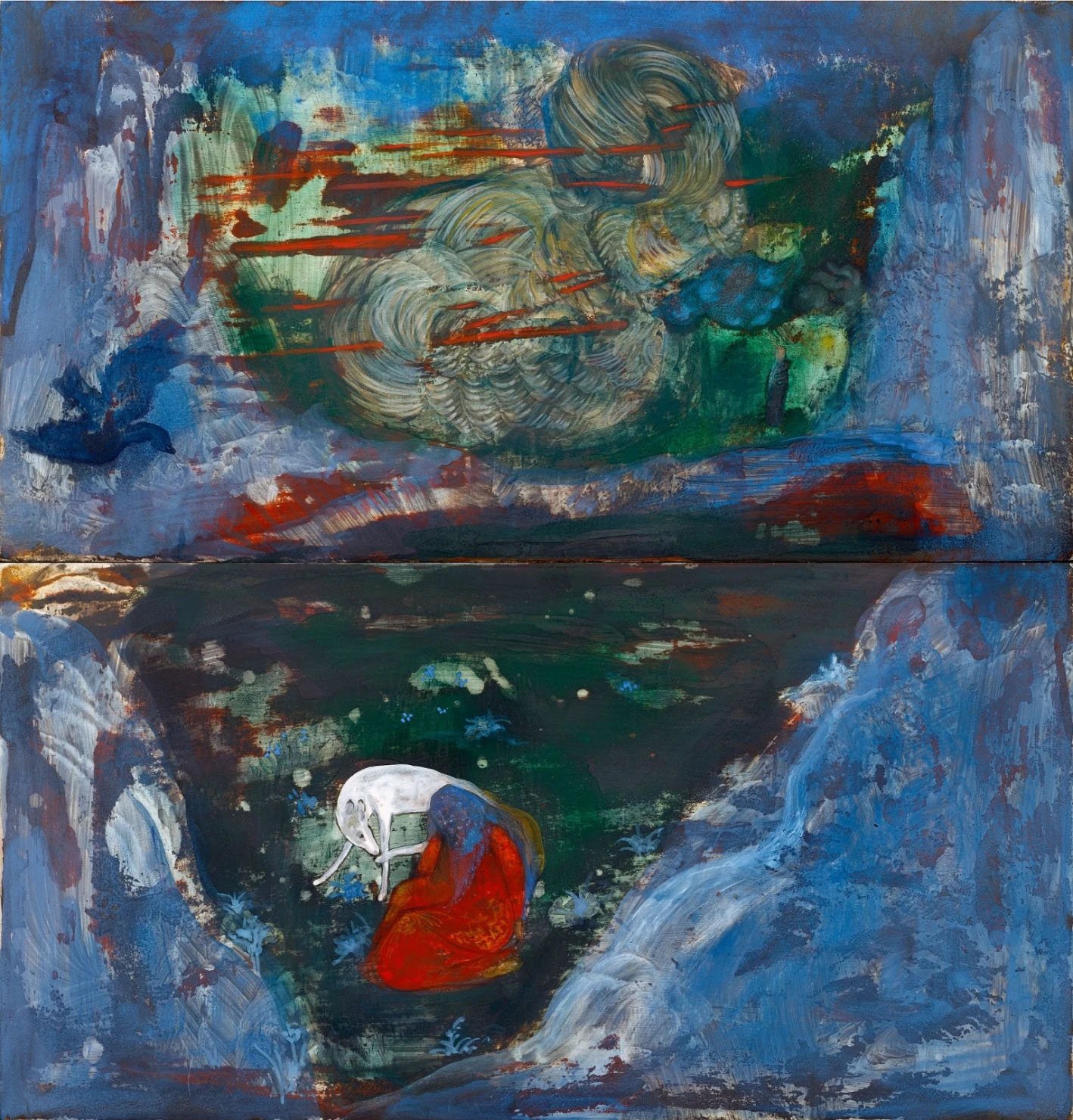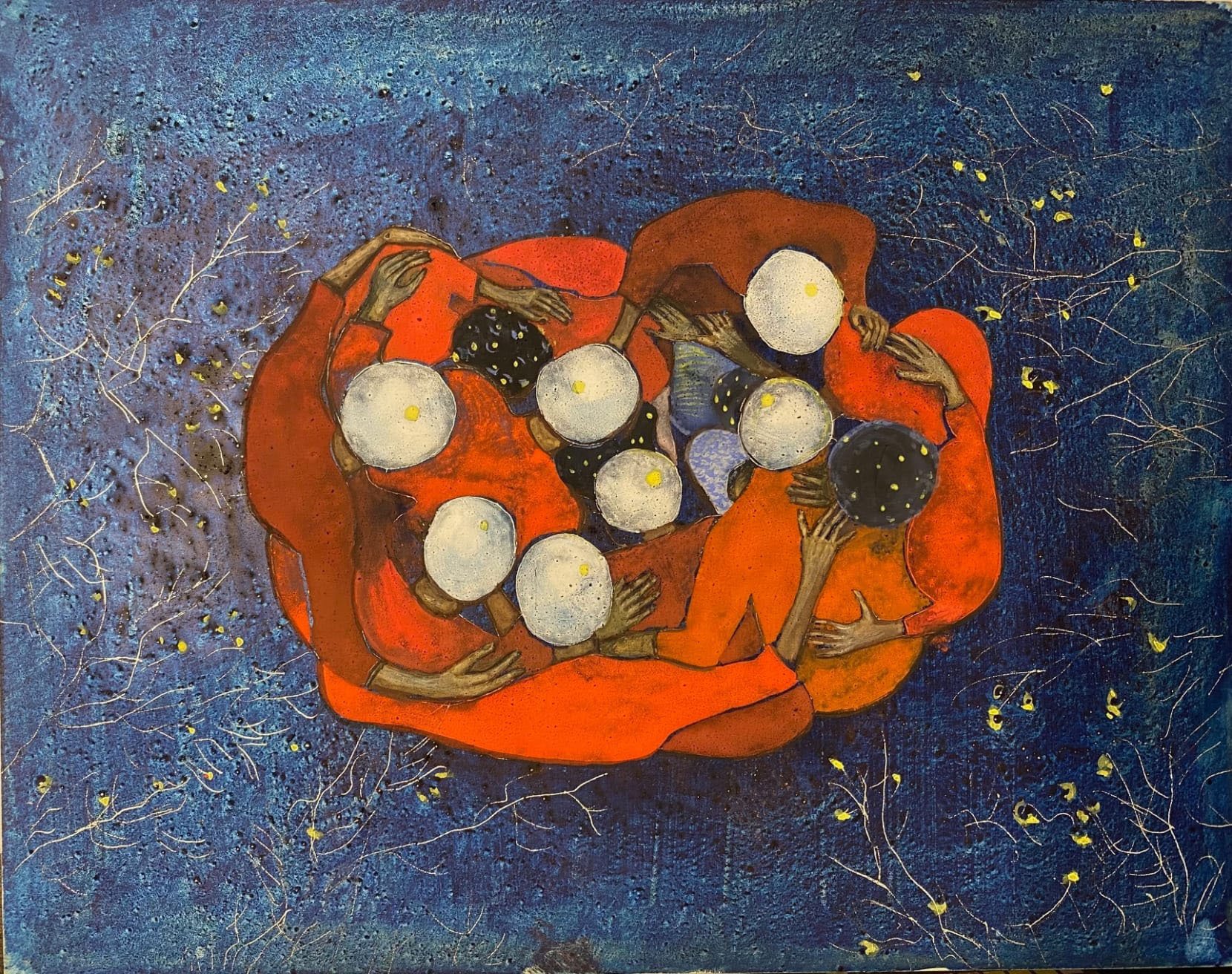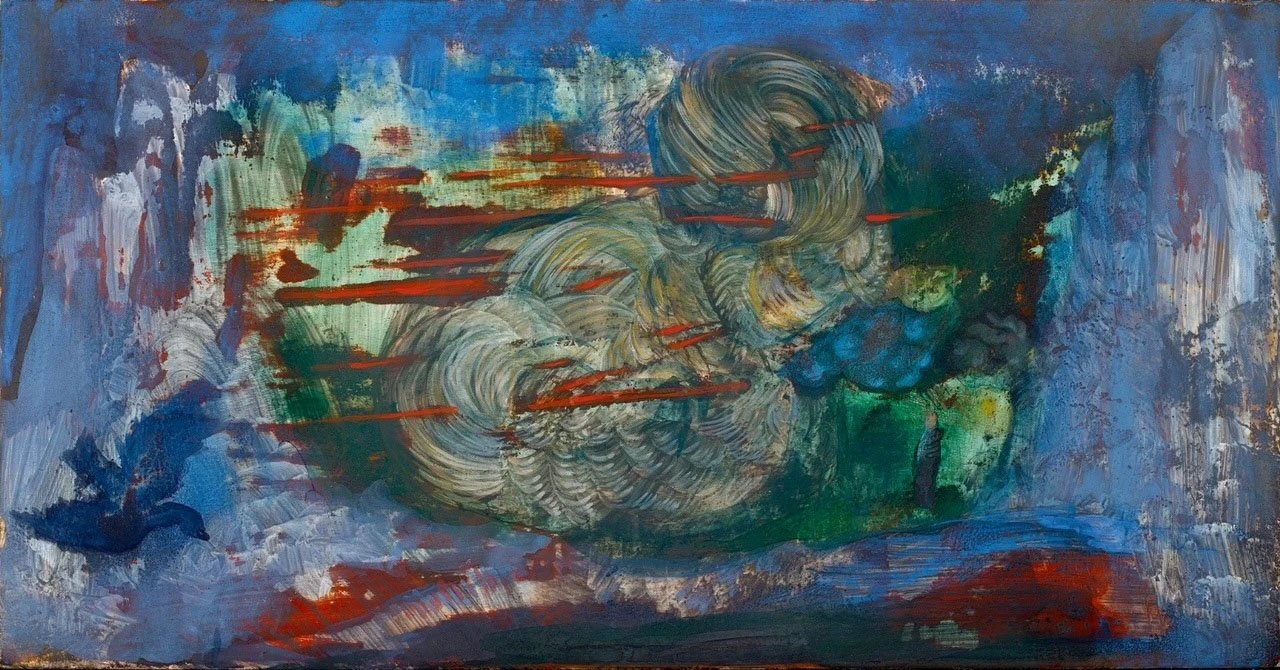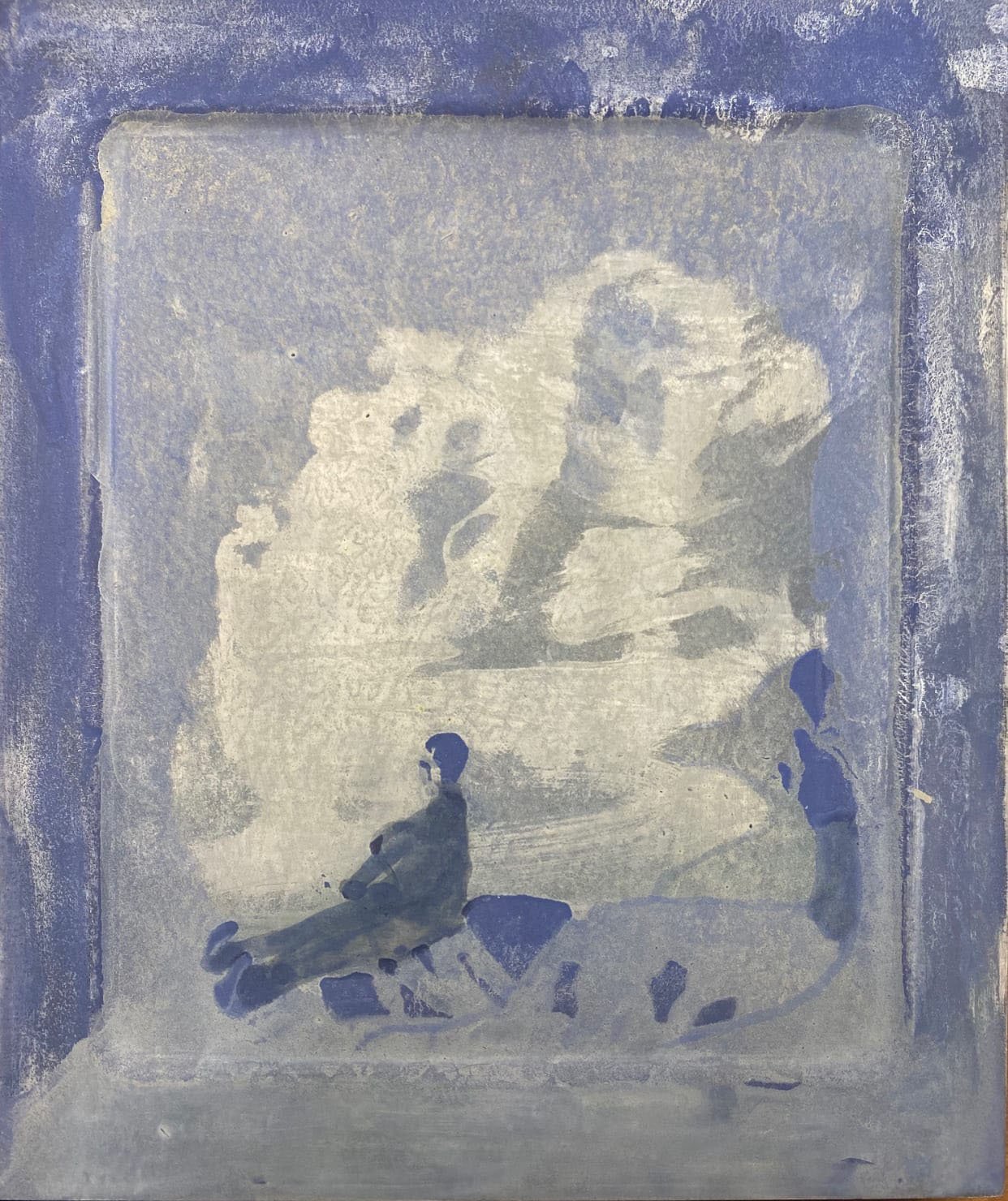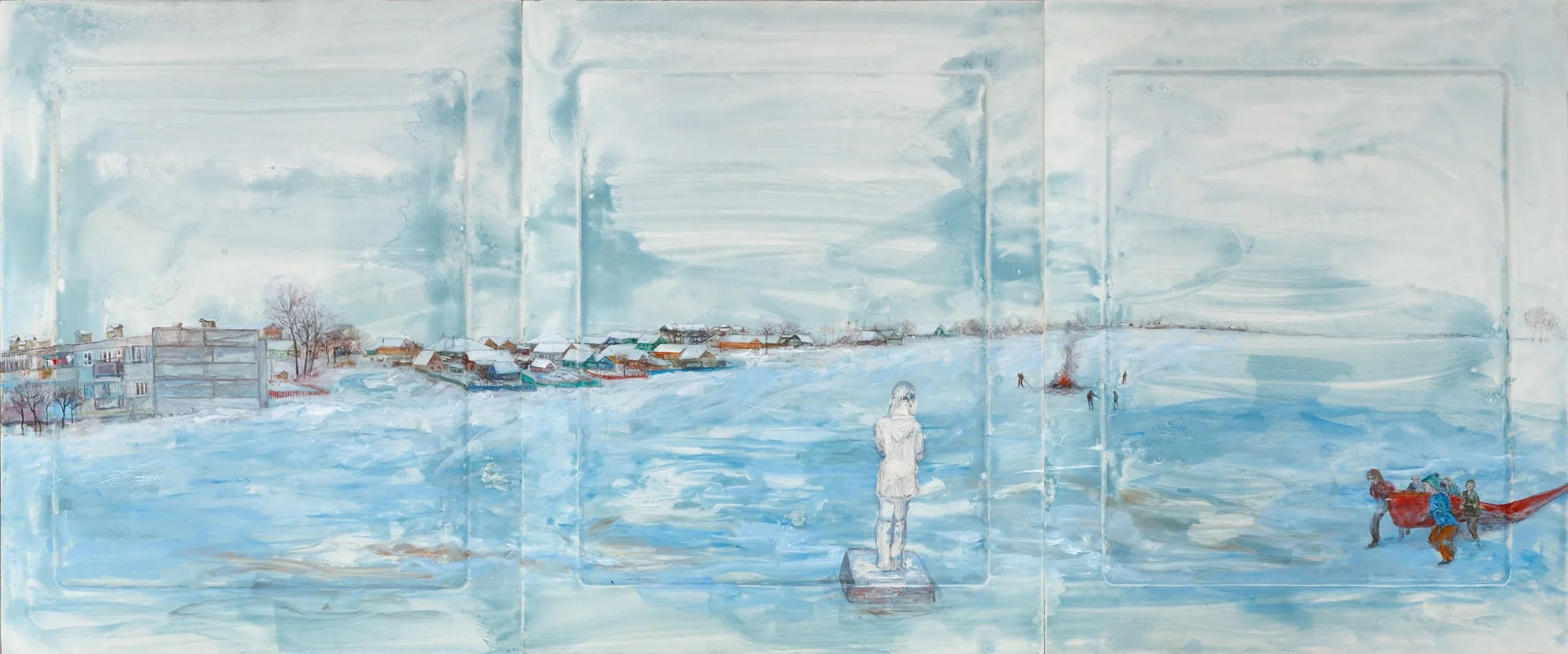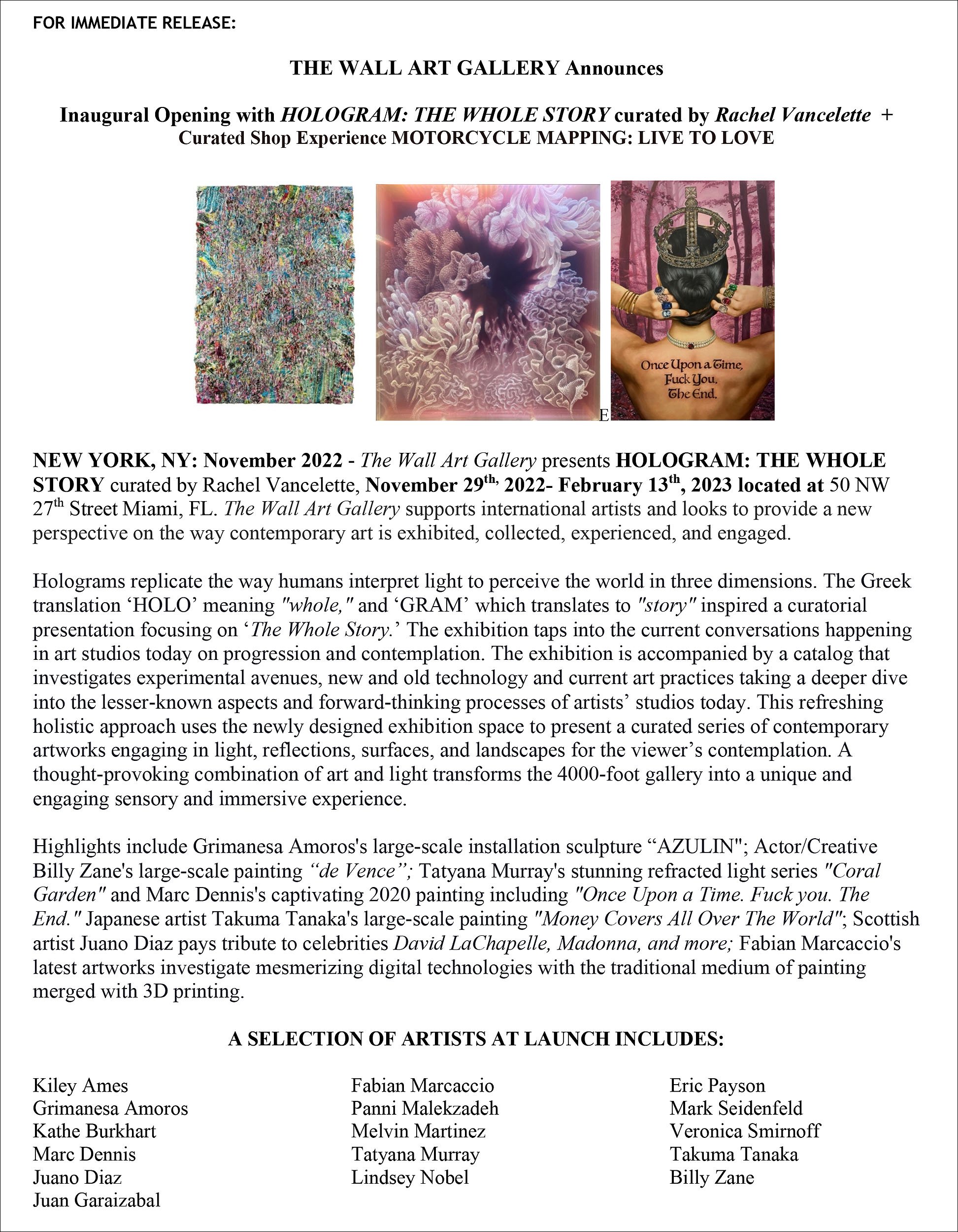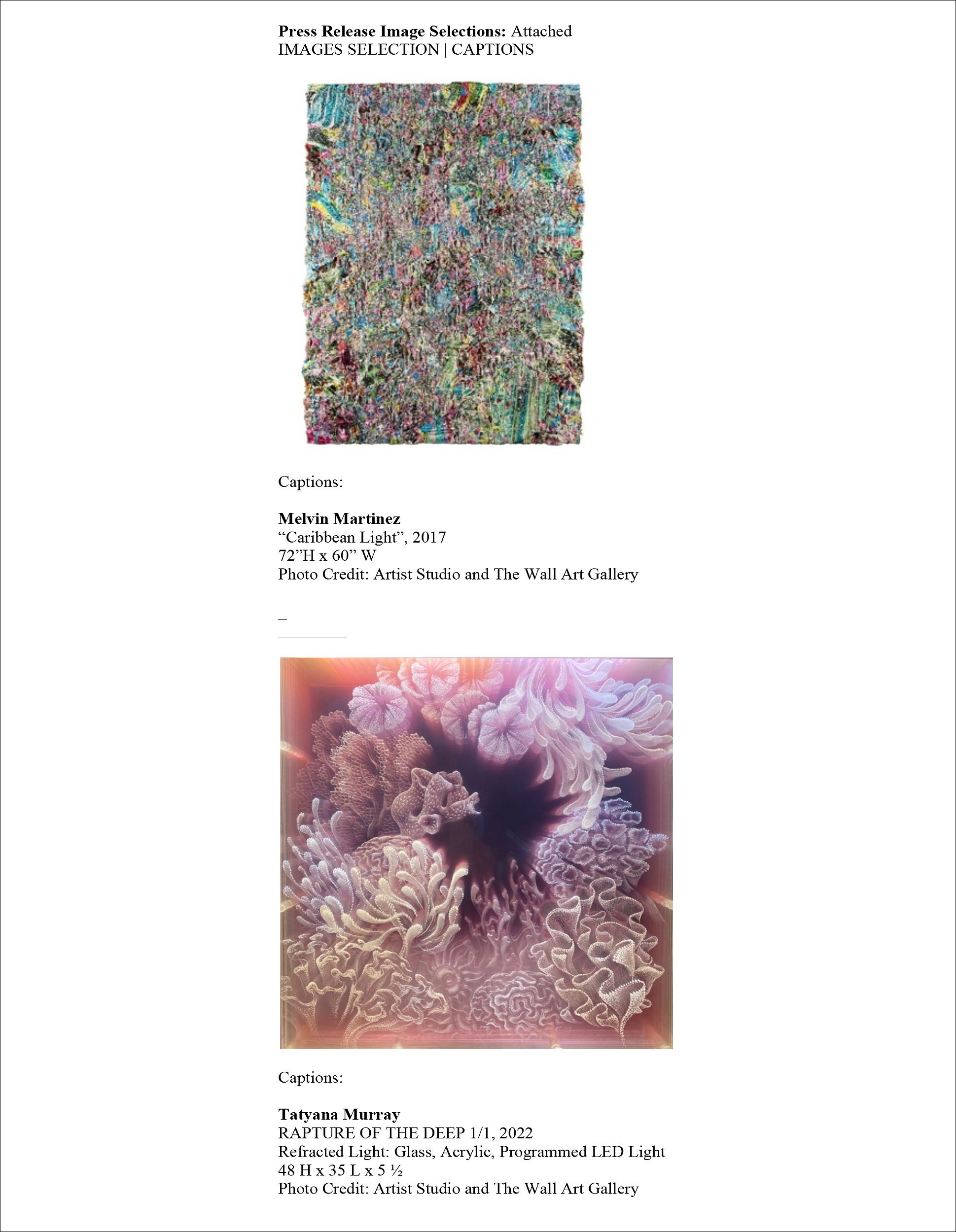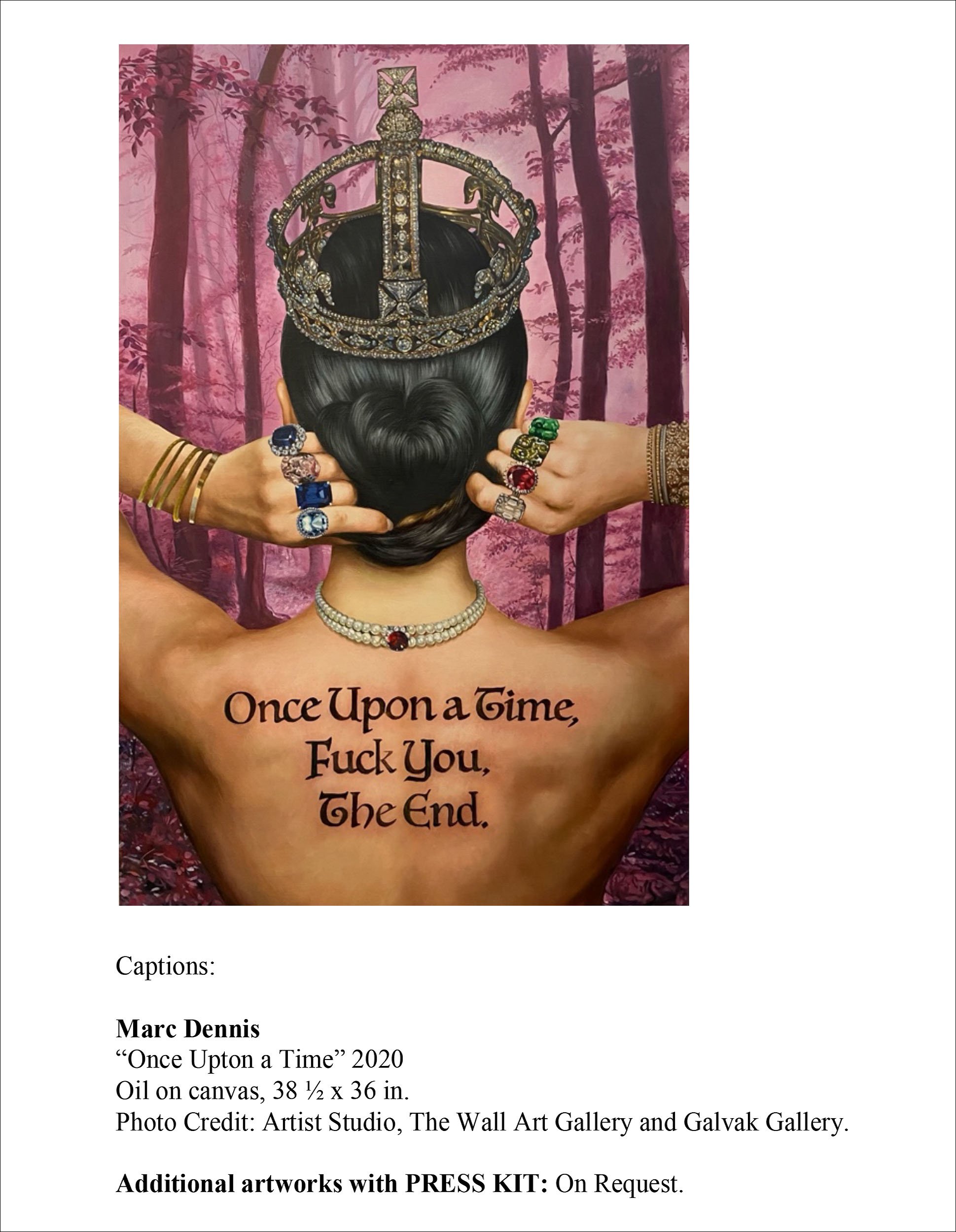Jamie Macleod Bryden attends Veronica Smirnoff’s “Blue Sky Red”, her largest solo exhibition to date in the UK. The artist kindly discusses the exhibition with him afterwards.
Presented by the Candida Stevens Gallery, it is comprised of twenty years of material under one thematic whole. A pale white flowing figure, atop a horse, veers towards a precipice of jagged and rippling dark blue with a roaring wall of pale blue dominating their path, overhead an ominous sky. The eye shifts perspective and is then drawn to the symbology of multiple white concentric circles emanating from that sky. The only warm colour set against this symphony of blues is the tiny red shoe of the rider – this small figure engulfed in the vastness of nature. Another vision includes a cloaked figure, peering stoically into a reflection amidst a labyrinth of blue and red squares, resembling a chessboard, backed by a wall on which a skeleton looms. The cloak is adorned with red winged icons that look like angels; but the red could also stir something more ominous, depending on the eye of the beholder. Set in a deep blue starry frame that spreads itself into the very piece and feels…eternal.
These are just a couple of worlds created by Smirnoff in her retrospective, they beckon and pull you in: “Moonlight Flit” and “Blue is Darkness made visible” respectively. Each piece feels like it bends reality itself into a fluid liminal zone. One of the ways Smirnoff describes her work is as “Blue Sky Visions” where her aim is to: “Recapture the sense of mystery, the strange and the unknown that oscillates between the breakable and the unperishable, reflecting the fluidity of the human experience. It’s my sentiment towards the whole world we live in. The body of work tells stories of everyday magical and imagined situations in a space that is neither here nor there but unerringly both. The motifs celebrate life in its brightness and fragility.” In these works, which range from portraiture to vast fantastical landscapes, we can see the exploration of the boundaries between imagination and reality. She references Einstein’s notion that imagination is more important than knowledge itself. Through her inventive shifts of perspective. Through the way the viewer can see different images within the larger image: “Tilted perspectives, temporalities, geographies, iconography, and time become variables imbued with complex reality.
Blue Sky vision relates to the relationship between self and space, self and others, form and content, unconstrained by practicalities. I am “Blue Skying” around the notion of “ the Blue” that makes us happy, like a simple blue sky above our heads or makes us sad and “gives us the blues”. The colour itself is malleable, neutral in its nature, it is always the filter we apply to it”. Veronica notes that blue is traditionally associated with loyalty, wisdom, love and faith eg “True Blue” and rarity “once in a Blue moon” but she enjoys this notion that it can change depending on the viewer and their sensibilities…or politics.Ostensibly opposite colours like red (more associated with anger, courage but also love) can even take on the same meaning at times. This is perhaps not as surprising as it may at first seem given that her favourite blue “Prussian Blue” (often employed as the base of each work) is actually derived from a red dye. So, the fluidity that she mentions even extends to the colour theory employed in her work too. These pieces become figurative prompts for us not to lose our childlike sense of wonder with the world. Which is all too muddied and readily forgotten in adulthood. In this vein she references one of her favourite writers – JK Chesterton: “You cannot imagine two and one not making three but you can always imagine trees not growing fruit; you can imagine them growing golden candlesticks or tigers hanging on by the tail.”
For Veronica, maintaining childlike wonder and imagination is something that she has valued and cultivated since her own childhood. Being able to feel awe is akin to the benefit of looking at something through a completely fresh pair of eyes. She feels that fairy and folk tales have a lustre that can teach us about reality too. One example being the “Mistress of the Copper Mountain”. A Russian fairy tale about a beautiful green-eyed maid in a malachite gown who entrances the miners of the Urals. It has a strong message about desire and links to her love of colour too, as the malachite and other colours of the mine are a vital part of making the story come to life, adding inherent beauty.This contributes to Veronica’s own folkloric world which synthesises these influences into something new. She is alive to the possibility of influence everywhere though, whether that be the flow of something in nature to things like Sufi patterns to more modern works like Blue by Derek Jarman. She has countless influences in art itself, but film is also attractive to her because it is not static and offers fresh perspective: “I am inspired by the most random things. Sometimes you just see something, but you zoom into the detail, and it sort of leaves a lasting impression. It becomes a wonderful osmosis. You start this creative process and incredible things come from this really tiny thing.”
This preservation of childlike wonder has then been augmented through her love of art history and seeing links between different periods. She muses that much like musicians see patterns in their art; her love of art history and different cultures has prompted her to see patterns in seemingly disparate sources: “I’ve always been fascinated by art history. I love this idea of the connection between the Asian tradition and visual culture, but then the more you look at it the more you understand that this is linked to Byzantine culture. And then you think of folk art and miniature painting, you find so many interesting similarities. We are used to expressing the world through Western perspective, whereas the Byzantine lack of it or sort of tilted depth in iconography are unerringly the same as you find in Chinese scroll paintings or Japanese prints. You seek it out and that’s where the freedom and magic come into play…”
For Veronica, this journey towards where she is now, began when she studied the ancient method of Egg Tempera at a Russian monastery: “I was an apprentice to an icon painter. He was restoring and reviewing the frescoes in this dilapidated monastery, post Soviet Union collapse, when the renaissance of religious sites began in Russia. He was my spiritual father in a sense because I had just lost my father. There was a very deep connection there. This is how I learned the technique, the foundations of icon painting and seeing at first hand this incredible history at play.” Her love of the process is informed by how unpredictable it is. When she starts a piece, she can never be entirely sure what the end point will be. It is a life pursuit – given its difficulty to master: “Pigment is pernickety and hard. The process has its own inner logic. If you get the proportion of the ground pigment and egg yolk wrong, the whole emulsion fails. It’s precise and yet unpredictable. I became fascinated and transfixed by its prescriptive methodology. That’s how it all started. Then the fluidity of the paint itself means it has to be applied horizontally in blobs and splatters, you leave it to the mercy of chance as it dries and makes the shapes with a somewhat 3D effect.”
Within this difficulty lies possibility. She has a love for the medium and the mystery it presents and where this can then go:“I like sanding the layers of pigment down. Going up and down with this luminous work where build layers to a sedimentary base. There are different ways of using Egg Tempera, but layering is fundamental. You start with a Saint’s face in a dark shade of brown, almost black and build layers until it becomes luminous. The depth is incredible as you have gone from blocky dark to transparent light .” Even with the very materials that she starts with – there is meaning behind them: “The monastery still provides me with these panels. What they do is fantastic because you end up with this very precious object. Beautiful wood and this very smooth kind of marble-likesurface. It just feels so precious. Robust yet fragile. I love the physicality of the fragile element versus the very tough wood. When these panels arrive, they look like artworks themselves.” It really augments the meaning behind these pieces, each starting of as a sacred object in its own right: but she always wants the viewer to find their own meaning in her work: “Co-creation. I think the viewer needs to do their part. It’s not just about my authorship, this is a conversation and that’s what completes a work. I think it’s important to leave space for imagination so that you can roam freely.” As mentioned prior in relation to how the viewer interprets colour. She loves the idea that depending on the sentiment or perspective that the viewer brings to the experience that blue itself can have multiple interpretations as either a positive or a negative colour. Her work will always leave that vital space for the imagination: “I’ve always been a figurative painter. Figuration into abstraction and back. It becomes a journey where the meaning can be interpreted and reinterpreted, seeing figures in clouds or veins of wood.” She modestly claims that she still doesn’t feel like she has achieved this aim yet, the purity of that intention can be worked towards endlessly.
The idea of purity of intention is something that comes up when we discuss other mediums and how she has come to value them over time. From the starting point of pencil to newer mediums like pastels and tapestry: “You always doubt what you do with drawings but that’s when your idea is pure and simple. The painting might not bridge the gap between the realisation and the original idea. “This was the initial idea; this is what I was really thinking””. We discuss the value of seeing the very genesis of an idea when it was at its most pure and how the tracking of that journey can be just as satisfying for viewer and artist, than just a finished product in the final medium. Like how demos in music can offer a satisfying window into the artist’s creative process as it reveals the start point. Another medium that Veronica has recently been exploring is tapestry, of which there are three featured: “The Tapestries have been a revelation; they add to my practice. Painting is always the subject, but doing something different gives insight into other ways of working and seeing.” Despite these newer mediums offering fresh perspective. She is grounded in one overriding principle: “The subject always remains painting itself”. You get that sense that Veronica has many more questions to ask and explore through her work. A journey closer to its beginning, still yielding mysteries and uncovering new ones: “Blue and colour discourse, there’s so much there…I haven’t finished with it yet.” You can feel that excitement she has – to dive back into these exploratory blue worlds. Like the miner in the folk tale going back to the Malachite mine. It comes back to a favourite aphorism by Delacroix: “Colour is surely that part of art which contains the gift of magic.” Once on that path. There is no going back.
























